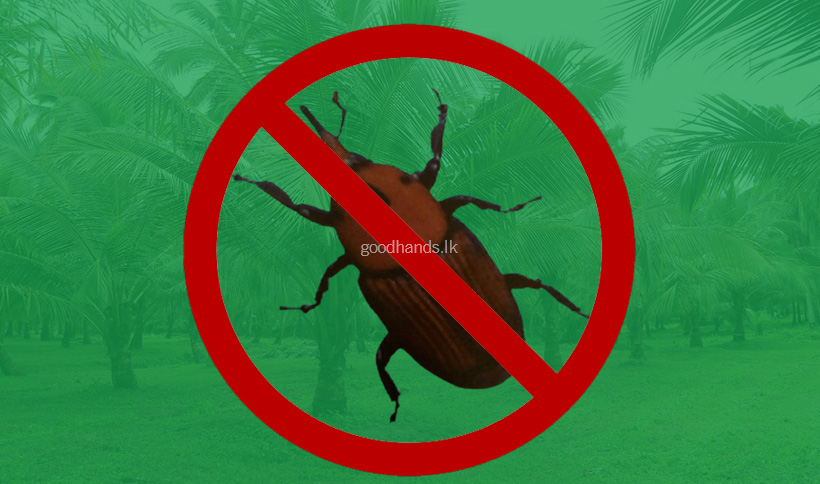6.1 පළිබෝධ
I .කෘමි පළිබෝධ
II. ක්ෂීරපායි සත්ත්ව හානිය
III. ක්ෂුද්ර කෘමි පළිබෝධ
කෘමි පළිබෝධ
1. Termites
It damages the husk of the coconut plant initially and the base subsequently. When the nut is examined the damage to the husk will be visible. The withering of the shoot also could be seen. When the withered shoot is pulled by hand it will easily come out.
-මර්දනය-
If the damage by termites is minimum it has to be removed and for chemical treatment, 1-2 mls of “Itdakloprid 20% “ dissolved in 1L of water and the plant should be submerged for about 3 minutes.
2. Plesispa
This attacks plants up to 5 years of age. The insect lives in the unopened long leaves. Long lines and spots will get visible and become brown-coloured and dried up later.
-මර්දනය-
Chemical treatment is injecting into the shoot Carbosalfan 3ml diluted in I L of water.
3. කළු කුරුමිණි හානිය
මෙහිදී වන්නේ ගොබයට දරුණු ලෙස හානි සිදු වූ විට ගස්වල වර්ධනය මැලවීම හා පීදීම ප්රමාද වීමයි. මෙහිදී ගසේ ගොබය ප්රදේශයට හානි සිදුකරන අතර කුඩා පැළවලට හානි සිදු වූ විට ගොබය මැරී යාම හෝ වක් වූ ගොබයක් දැකිය හැකිය.
-මර්දනය-
It is important to maintain the cleanliness of the land. Beetles lay eggs on organic matter, hence coconut trunks, cow dung, and rubbish heaps must be removed.
Keeping two camphor balls on fronds closer to the shoot and applying burnt engine oil on the fronds surrounding the shoot. Placing of pheromone traps purchased through the Coconut Development Officer of the area.
4. රතු කුරුමිණි හානිය
This is the death knell of the coconut plantations and coconut trees of 3 to 10 years of age get affected. The eggs are laid in the cracks of the trunk, soft roots, damaged etc. The worm gets out of the egg gets into the trunk and attacks the internal tissues resulting fall of the tree either at the shoot or at the base.
* ගසේ සිදුරු ඇති වීම.
* සිදුරු අසල ඕජස් ගැලීම.
* අතු ලා කහ පාට වීම.
* ගොබය මැලවී යාම.
* Hearing of sounds when the ear is placed onto the trunk
-මර්දනය-
මර්දන සඳහා පහත දැක්වෙන ක්රමයන්ගෙන් එකක් යොදාගත හැක
* අවුරුදු 3-10 ත් අතර ශාක හොදින් පරික්ෂාකර තුවාල ඇත්නම් දැවි තෙල් ආලේපය.
* විශාල සිදුරු සිමෙන්ති යොදා වැසීම.
* අතු කපන විට අඩි 03ක් පමණ ඉතිරි වන සේ පිත්ත කපා දැවි තෙල් හෝ දියර තාර ආලේපය.
* To close the holes at the bottom of the tree with soil.
* Removing damaged trees, cutting into small pieces and burning them down.
නිර්දේශිත රසායනික
I මොනොක්රොටපොස්
40 ml injected into the matured tree trunk කරනු ලැබේ.
II. පෙන් කොයිට්
Divide into 3 equal portions 40ml. Drill three holes of equal height 6” above the damaged area and apply the portions.
III. වර්ටැකෝ
Dissolving 40g in 250ml of water and injecting through two holes made 1-2 feet of height. For each hole, 30ml has to be injected. Syringes must be used and after 3 days holes must be covered using cement.
Additionally through the Coconut Development officer of the Area, advice on Red Beatles pheromone traps and instructions and use in the field.
5. Mite
This has become a major crisis for the coconut plantations on the island. Small tender coconuts get damaged through this. Mites live about three months feeding on the soft cells of the small tender coconuts.
When observed a yellow-coloured triangular spot appears and it grows gradually and becomes brown-coloured, resulting in:
* Falling off nuts
* ගෙඩි කුඩා වීම
-මර්දනය-
* Using Sulphur- Palm oil mixture Sulphur and (add the method of making the mixture)- How to make the mixture: to 800 ml of water add and mix soap powder 12 gms and sulphur 5 gms well and add palm oil 200 ml)
* Using natural enemies of pests
ක්ෂීරපායි සත්ත්ව හානිය
පොල් වගාවේ පළිබෝධ හානිය පිළිබදව සැලකීමේදී මෙම හානියද සැලකිය යුතු මට්ටමක ඇත. වගාව පැළ අවස්ථාවේ හා පල දරණ අවධියේ හානිය අධික වේ.
* වල් ඌරා
* ඌරු මීයා
* ඉත්තෑවා
* රිලවා
* වඳුරා
* අලි
* දඬු ලේනා
-මර්දනය-
* පැළ වටා බැරල් යෙදීම
* Fixing poles and tying those with plastic sheets
* පස් පිරවූ ටයර යෙදීම
* ග්ලිඩිසීරියා ලී සිටුවීම
* Using firecrackers
ක්ෂුද්ර කෘමි පළිබෝධ
1.Yellow-spotted locust – Aularchesmiliarris
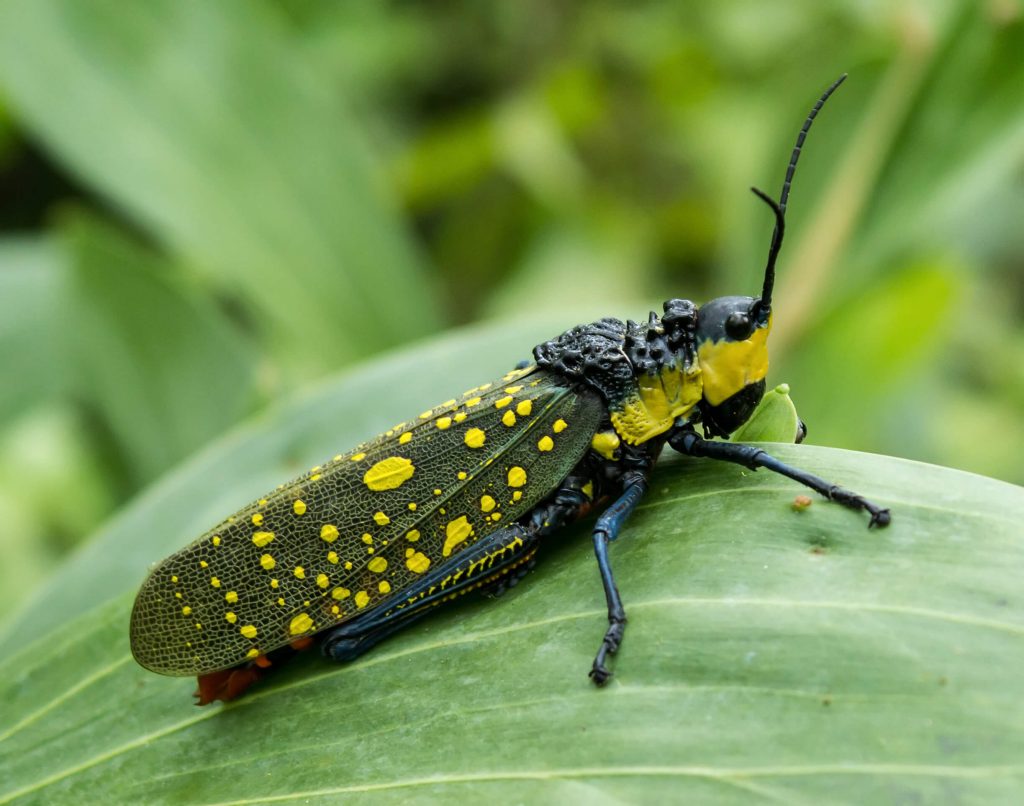
පළිබෝධකයා පිළිබඳ විස්තර
The first record that the yellow-spotted locust damages the vegetation was in 1947. This pest had been seen in many parts of the Island and records indicate its population had heavily increased in many instances. Female pupa makes a hole in the soil and lays eggs about 3-4 inches below the ground in cluster form. Each cluster may carry 15-60 eggs. It creates a cover with phlegm to protect the eggs. Laying of eggs takes place mostly in October and November it selects areas well covered under large trees. The insects coming out of the eggs are brown in colour. Within 1-2 days those will become black in colour and yellow coloured lines could be seen along the bodies. There will be 6 stages of larvae of the yellow-spotted locusts and it will take 5-6 months to complete the larva stage. This pest lives in groups and each group will have 3000-4000 or more. The locust is about 1 ½ inches in length and a grown locust will be about 5 c.m. (2 inches). Its head and antennas are black in colour.
උවදුරේ ස්වභාවය සහ එය හඳුනා ගැනීම
පොල් ශාක පත්ර කා දමයි.
-මර්දනය-
⦿ A collective effort is needed to control the yellow spotted locusts and should be vigilant for their arrival. During the months of October and November, those will arrive under the shade of large trees and it is possible to collect them with hands and destroy them. At this stage, the pupas are not active and they could be collected with hands.
⦿ සතුන් බිත්තර දමා ඇතැයි සැක කරන ස්ථාන හඳුනාගෙන එම ස්ථානවල පස පෙරලීමෙන් බිත්තර කැදලි හිරු එළියට නිරාවරණය කිරීම තුළින්ද, එම කැදලි කුරුල්ලන්(විශේෂයෙන් - මයිනා), කුහුඹුවන් වැනි සතුන්ට ආහාරයට ගැනීමට සැලැස්වීම තුළින්ද විනාශ කළ හැකිය.
⦿ Make a mixture with 2 litres of water, 10 m.l. of kerosene and 10g of soap in a bucket and collect the pupas into the bucket. As the pupas are dormant in the morning due to low temperatures collecting those has to be done in the morning hours.
⦿ When the damages are acute spray carbosulfan 3m.l. mixed with 1 litre of water.
2. කොරපොතු කෘමියා
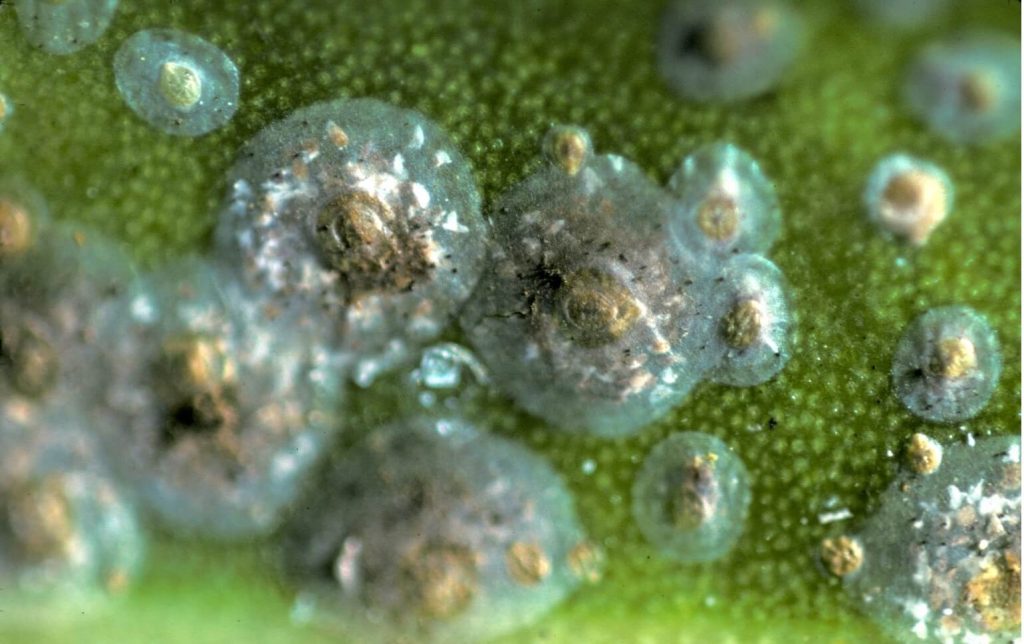
පළිබෝධකයා පිළිබඳ විස්තර
Coconut scale is a species that destroys coconut leaves in all areas where coconuts are planted in Sri Lanka. Since the dry season is conducive to their growth, during long droughts these pests could be seen often. Their population will decrease during the rainy season. These pests sucking the juices under the coconut leaves could be seen by using a magnifying glass. The centre of these pests is yellow in colour and surrounded by a transparent cover similar to a fried egg (bull’s eye).
උවදුරේ ස්වභාවය සහ එය හඳුනා ගැනීම
Affected coconut trees could be easily identified by the small yellow coloured spots on the coconut leaves. When examine under the leaves these pests could be detected. Those are yellowish-white in colour. When the affected areas of the leaf are scratched with a fingernail there will be wetness with moisture if the live pests are available, if the pests are dead there will be a dried powdery feeling to the touch and scales will get gathered around the end of the fingernail. When the pest population is heavy the whole coconut branch will become yellow in colour and get dried up. At this stage, it can damage the flowers and small very tender fruits. When the plants get damaged their growth will be affected.
-මර්දනය-
⦿ ශෂ්ය විද්යායාත්මක ක්රම - උවදුර අතු කීපයක පමණක් දක්නට ලැබුනොත්, එම අතු කපා පුළුස්සා දමා මුල් අවස්ථාවේදීම මර්දනය කළ හැක. එසේම පැළ වල හානිය දක්නට ලැබුනොත් එම පත්ර කොටස් කපා දැමීමෙන් හෝ අතින් පොඩි කර කෘමීන් විනාශ කර දැමිය හැක.
⦿ Biocontrol methods – Ladybird insects are natural predators capable of controlling these pests. There are two varieties – one is known as “Chilocorus nigritus” – a round-shaped insect of a size of a pepper seed and the other is “Pallas sirumpilinus” which is slightly smaller than the previous one. Its worms are white in colour and spread similar to the shape of fingers on its body. Both these varieties are greedy eaters and could successfully control the damage by coconut scales
⦿ Chemical methods- These methods should be considered only if the bio-controlling methods had not been successful in controlling the pests. The advice of the coconut development officer of the area has to be obtained. A mixture of 20-40 ml of dimethoate 40% and hoklopairofos 40% mixed with 10 litres of water has to be sprayed on the plants using a knapsack sprayer. For grown-up trees 8 m.l. of Monocrotophos 60% can be injected into the trunk.
3. කුසීත දළඹුවා
පළිබෝධකයා පිළිබඳ විස්තර
This caterpillar is known as a pest that damages severely the coconut leaves in the coconut plantations in the dry zone which had not come to much attention. This pest damages the growth in all stages from the nursery to the grown trees. At the grown stage the pest is a moth and both sides of its head are light green and its wings are light brown in colour.
උවදුරේ ස්වභාවය සහ එය හඳුනා ගැනීම
Dark brown patches could be seen underneath the coconut leaves. When the caterpillars gradually grow they destroy all the leaves leaving only the ankles. As they like well-matured leaves there is a tendency to gradually damage from the lower branches to the upper branches.
-මර්දනය-
⦿ If the damage is for 50 or fewer trees the lower branches could be cut off using a picker and burnt down.
⦿ The parasite “Apantalis Parase” is used as a natural predator. Its behaviour depends on the weather patterns. Instructions must be obtained from the Coconut Development officer.
⦿ Only when the effectiveness of the parasite is not satisfactory, it is recommended to use pesticides. 8 m.l. of Monocrotophos 60% to be injected into the trunks.
4. එළි මිනිස් දළඹුවා
පළිබෝධකයා පිළිබඳ විස්තර
මෙම දළඹුවා තවාන් පැළ හා පොල් පැළ වලට හානි කරයි.
උවදුරේ ස්වභාවය සහ එය හඳුනා ගැනීම
⦿ කුඩා පත්ර කතුරකින් කැපූ ආකාරයට කා දමා තිබීම.
-මර්දනය-
⦿ Destroying the caterpillars after collecting them by hand. Spraying a mixture of carbosulfan 3 m.l. in 1 litre of water
6.2 රෝග
i. Oozing out the sap from the bark
ii.කඳින් ඕජස් ගැලීම
iii. Rotting the shoot (Bud Rot)
1. Oozing out the sap from the bark
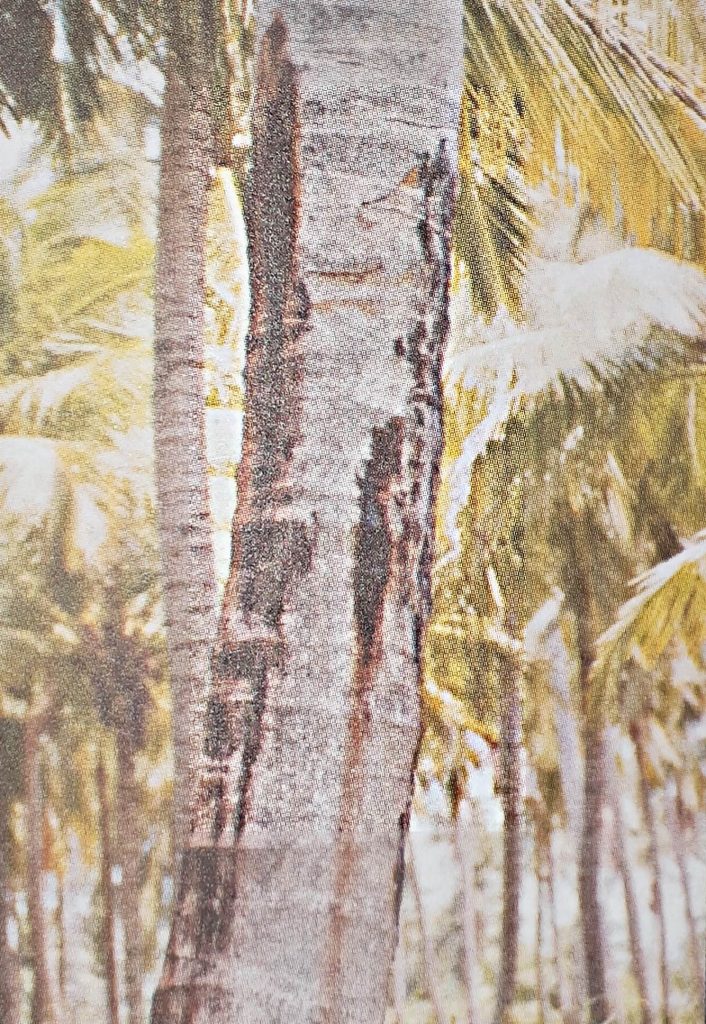
රෝගය පිළිබඳ විස්තර
Oozing juices out of the coconut trees is a common occurrence. However, if the tree is infected with the fungus “Cerosistas Paradoxa” treatment must be done to control the disease.
උවදුරේ ස්වභාවය සහ එය හඳුනා ගැනීම
⦿ The main symptom is oozing out red-brownish sap out of the length-wise cracks on the bark. The oozing-out spaces will gradually become brownish and finally turned into a colour of blackish
⦿ Tissues under the bark where the sap is oozing out will turn yellowish and later will become brownish and get rotten away. Finally, the whole area will get decayed leaving out only the fibre. Places, where the sap oozes out, will gather together and form large oozing-out areas. After some time oozing will stop and the sap will get thickened and become like gum.
⦿ කඳින් ඕජස් ගැලීම “ගැනොඩර්මා” නම් දිලීරය ආසාදනය වූ ගස් වලද දක්නට ලැබෙන රෝග ලක්ෂණයකි.ගැනෝඩර්මා දිලීරය ආසාදිත ගස් ලංකාවේ දක්නට ඇත්තේ ඉතා කලාකුරකින් වන අතර එම ගස් වල කඳේ බිම් මට්ටමින් හතු ඇතිවීම මෙම රෝගයේ විශේෂ ලක්ෂණයකි.
⦿ ගිනිමැල ගැසීමෙන් , අකුණු සැර වැදීමෙන් ද, රතු කුරුමිණි උවදුරින් හානි වූ ගස් වලද, අධික ලෙස රසායනික පොහොර යෙදීමෙන්ද, ජල ගැලීමෙන් සහ නිතර ජල මට්ටම වෙනස් වන ස්ථාන වලද කඳින් ඕජස් ගැලීම සිදුවිය හැකිය. ගිනිමැල ගැසීමෙන් හා අකුණු සැර වැදීමෙන් වන හඳුනා ගැනීම පහසුය.
ප්රතිකර්ම
⦿ Sick yellowish parts of the bark should be cut and removed by a sharp knife, a chisel or a hand adze. Till the healthy light red coloured tissue appears, sickly tissues must be removed. The parts removed must be burned down. “Bordeaux mixtures” or a fungus remover containing copper must be applied on the scratched-out parts (wounds). If a fungus remover with copper is used the quantity
has to be according to the instructions given in the label. After leaving for a few days to get dried up, the Bordeaux mixture must be re-applied.
⦿ After about 10 days, if the malady has not spread to other parts or the oozing is not visible, liquid tar is to be applied to the scratches (wounds). If it is difficult for cultivators to make the Bordeaux mixture, after cleaning off the oozing-out sections liquid tar could be applied.
2. Rotting and Withering of leaves (Weligama Coconut Leaf Wilt Disease)
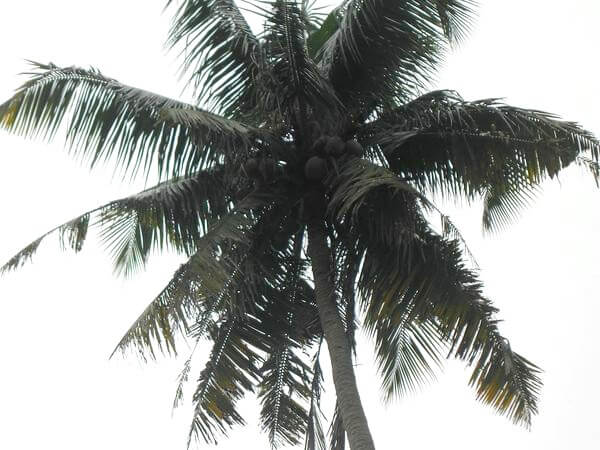
රෝගය පිළිබඳ විස්තර
A Disease known as Weligama withering and rotting of leaves was found in 2000 in the Southern Province. Now it has spread over the entire Matara district and in several divisional secretariats in Galle and Hambanthota districts. This disease was reckoned as an incurable pathogenic to “phytoplasma”. Through the gazette notification 1542/7 of March 24 2008 issued under the No. 35 of 1999 Act of Protection of Trees, it has been published this malady is a pandemic. In order to control the spread a buffer zone is an area without the disease.
උවදුරේ ස්වභාවය සහ එය හඳුනා ගැනීම
⦿ ගොක් අත්තේ කොළ වල ජලයෙන් පෙඟුණ සේ දුඹුරු පුල්ලි ඇති වීම
⦿ කුණු වූ ගොබයේ පත්රිකා ඇලී තිබීම
⦿ කුණු වූ පිති කළු පැහැවී බිලීපිති ආකාරයට දිස් වීම
⦿ කුණු නොවූ පත්රිකා කොළ පැහැයෙන් යුතු අතර
⦿ අග්ගීසි කළු පැහැ වී හැකිලී තිබීම
⦿ කරටිය කුඩා වීම සහ කඳ සිහින් වීම
These are the main symptoms of this disease.
⦿ පත්රිකා පැතලි වීම හා ඉළ ඇට මෙන් වක් වීම
⦿ පහත මාලයේ අතු කහවීම
⦿ කලාතුරකින් මැද මාලයේ අතු කහවීම
⦿ කහ පැහැ වූ පත්රිකාවල දාරය වියළී යාම
වැලිගම පොල් කොළ මැලවීමේ රෝග ලක්ෂණ වෙයි.
ප්රතිකර්ම
⦿ Tebukonosol – polikar / orayis and hexakonasol – shakthi/ kantap are the recommended fungus removers. Polikar / orayis 10 ml should be mixed with 1 litre of water. Shakthi / kantap 10 ml should be mixed with 1 litre of water. When fungus-removing mixtures are made plastic utensils must be used. Must cut off the parts of the tender coconut frond after climbing to the uppermost part of the tree. 3-4 branches closer to the shoot and the leaves that got rotten must be cut off. About 1 litre of the fungus remover must be poured into the shoot. The cut and removed parts along with the rotten ones should be burnt down. Later on, when the fungus remover is used it is not necessary to remove the rotten parts. But the new shoot must be widened and fungus remover must be poured in to get the shoot properly wet. This has to be continued for 3-4 months except during the rainy season. It is important to have a piece of proper knowledge of using fungus removers.
3. Rotting the shoot (Bud Rot)
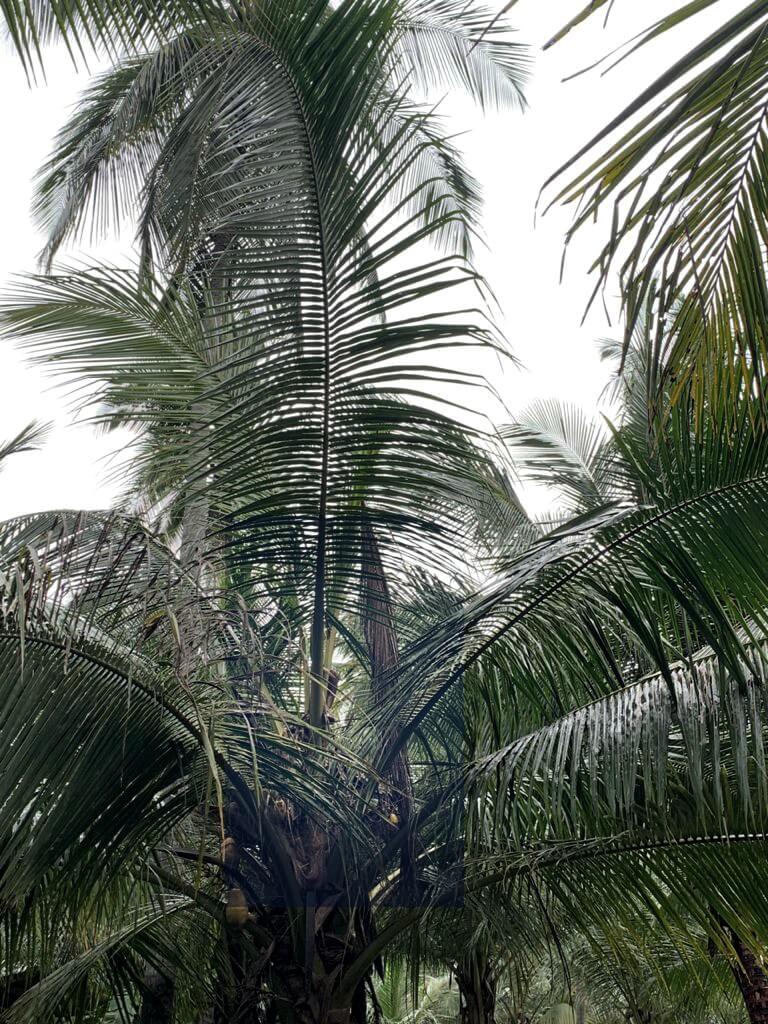
රෝගය පිළිබඳ විස්තර
This is due to a fungus called “phytophthora palmivora”.
උවදුරේ ස්වභාවය සහ එය හඳුනා ගැනීම
⦿ This disease is most prevalent among trees less than 45 years of age. The initial symptom is the fading of colour of the tender frond and getting withered. After that, it will become brownish and dried up.
⦿ ආසාදිත ගොක් අත්ත ඇද්ද විට පහසුවෙන් ගැලවේ. තවද එයින් ඉතා තද දුර්ගන්ධයක් නිකුත් වේ.
⦿ The healthy branches closer to the tender branch, though green in colour, will get dried up one by one. Finally, the shoot and dried-up branches will wither away and fall down.
ප්රතිකර්ම
මූලික අවස්ථාවේදී එනම් ගොක් අත්ත මලානික වීම හඳුනාගත් විට නිර්දේශිත ප්රතිකාර කිරීම මගින් රෝග මර්දනය කළ හැක.
⦿ The infected shoot has to be cut off and fungus remover with copper 1% or a fungus remover containing metalaxyl 4g s mixed with 1 litre of water should be used to wash well the shoot twice a week.
⦿ To save the surrounding trees dithiocarbamate 6g s or metalaxyl 4g s dissolved in 1 litre of water and with the mixture wash the shoots well once in three weeks during the rainy season
⦿ Furthermore, by managing properly the nutrition the strength of the trees could be maintained. For this purpose, it is important to use a balanced fertilizer mixture.
සැලකිය යුතුය: රෝගයට තදින් පාත්ර වූ ගස් බේරාගත නොහැකි වේ. මේවා පුළුස්සා දැමීම ඉතාමත් වැදගත්ය. එමගින් නිරෝගී ගස් වලට රෝග බීජාණු පැතිරීම වැළැක්වීම හා තවදුරටත් රෝගී ගස් වල ඇති බීජාණු ගුණනය වීම වළක්වා ගත හැකිය.

